seats CHEVROLET OPTRA 5 2005 1.G Owners Manual
[x] Cancel search | Manufacturer: CHEVROLET, Model Year: 2005, Model line: OPTRA 5, Model: CHEVROLET OPTRA 5 2005 1.GPages: 336, PDF Size: 2.21 MB
Page 1 of 336

Seats and Restraint Systems........................... 1-1
Front Seats
............................................... 1-2
Rear Seats
............................................... 1-7
Safety Belts
.............................................. 1-8
Child Restraints
.......................................1-25
Airbag System
.........................................1-48
Restraint System Check
............................1-63
Features and Controls..................................... 2-1
Keys
........................................................ 2-2
Doors and Locks
....................................... 2-8
Windows
.................................................2-14
Theft-Deterrent Systems
............................2-16
Starting and Operating Your Vehicle
...........2-18
Mirrors
....................................................2-33
Storage Areas
.........................................2-35
Sunroof
..................................................2-38
Instrument Panel............................................. 3-1
Instrument Panel Overview
.......................... 3-4
Climate Controls
......................................3-21
Warning Lights, Gages, and Indicators
........3-26
Audio System(s)
.......................................3-42Driving Your Vehicle....................................... 4-1
Your Driving, the Road, and Your Vehicle
..... 4-2
Towing
...................................................4-33
Service and Appearance Care.......................... 5-1
Service
..................................................... 5-3
Fuel
......................................................... 5-5
Checking Things Under the Hood
...............5-10
Headlamp Aiming
.....................................5-37
Bulb Replacement
....................................5-38
Windshield Wiper Blade Replacement
.........5-44
Tires
......................................................5-45
Appearance Care
.....................................5-66
Vehicle Identification
.................................5-75
Electrical System
......................................5-75
Capacities and Specifications
.....................5-82
Normal Maintenance Replacement Parts
......5-83
Maintenance Schedule..................................... 6-1
Maintenance Schedule
................................ 6-2
Customer Assistance and Information.............. 7-1
Customer Assistance and Information
........... 7-2
Reporting Safety Defects
...........................7-10
Index................................................................ 1
2005 Chevrolet Optra Owner ManualM
Page 4 of 336
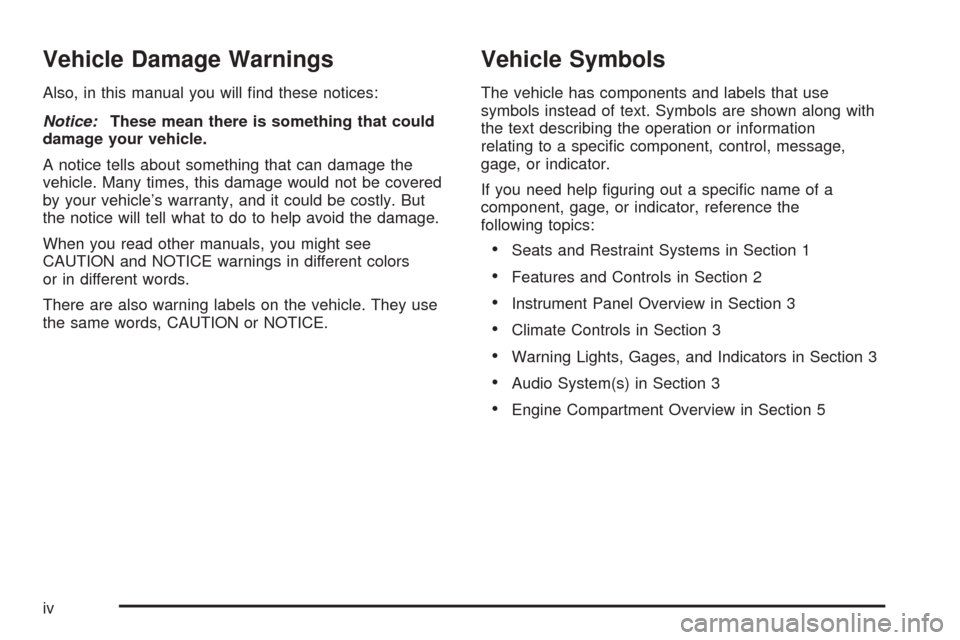
Vehicle Damage Warnings
Also, in this manual you will find these notices:
Notice:These mean there is something that could
damage your vehicle.
A notice tells about something that can damage the
vehicle. Many times, this damage would not be covered
by your vehicle’s warranty, and it could be costly. But
the notice will tell what to do to help avoid the damage.
When you read other manuals, you might see
CAUTION and NOTICE warnings in different colors
or in different words.
There are also warning labels on the vehicle. They use
the same words, CAUTION or NOTICE.
Vehicle Symbols
The vehicle has components and labels that use
symbols instead of text. Symbols are shown along with
the text describing the operation or information
relating to a specific component, control, message,
gage, or indicator.
If you need help figuring out a specific name of a
component, gage, or indicator, reference the
following topics:
•Seats and Restraint Systems in Section 1
•Features and Controls in Section 2
•Instrument Panel Overview in Section 3
•Climate Controls in Section 3
•Warning Lights, Gages, and Indicators in Section 3
•Audio System(s) in Section 3
•Engine Compartment Overview in Section 5
iv
Page 7 of 336

Front Seats......................................................1-2
Manual Seats (With Sliding Storage Tray)..........1-2
Manual Seats (Without Sliding Storage Tray)......1-3
Driver Seat Tilt Adjuster..................................1-3
Manual Lumbar..............................................1-4
Reclining Seatbacks........................................1-4
Head Restraints.............................................1-6
Rear Seats.......................................................1-7
Rear Seat Operation.......................................1-7
Safety Belts.....................................................1-8
Safety Belts: They Are for Everyone.................1-8
Questions and Answers About Safety Belts......1-13
How to Wear Safety Belts Properly.................1-13
Driver Position..............................................1-14
Shoulder Belt Height Adjustment.....................1-20
Safety Belt Use During Pregnancy..................1-21
Right Front Passenger Position.......................1-21
Rear Seat Passengers..................................1-21
Center Rear Passenger Position.....................1-24
Safety Belt Pretensioners...............................1-24
Safety Belt Extender.....................................1-24
Child Restraints.............................................1-25
Older Children..............................................1-25
Infants and Young Children............................1-27
Child Restraint Systems.................................1-31Where to Put the Restraint.............................1-34
Top Strap....................................................1-35
Top Strap Anchor Location.............................1-36
Lower Anchorages and Top Tethers for
Children (LATCH System)...........................1-39
Securing a Child Restraint Designed for
the LATCH System....................................1-41
Securing a Child Restraint in a Rear
Seat Position............................................1-41
Securing a Child Restraint in the Right
Front Seat Position....................................1-43
Airbag System...............................................1-48
Where Are the Airbags?................................1-51
When Should an Airbag Inflate?.....................1-53
What Makes an Airbag Inflate?.......................1-55
How Does an Airbag Restrain?.......................1-55
What Will You See After an Airbag Inflates?.....1-56
Passenger Sensing System............................1-58
Servicing Your Airbag-Equipped Vehicle...........1-62
Adding Equipment to Your Airbag-Equipped
Vehicle....................................................1-62
Restraint System Check..................................1-63
Checking Your Restraint Systems...................1-63
Replacing Restraint System Parts
After a Crash............................................1-63
Section 1 Seats and Restraint Systems
1-1
Page 8 of 336
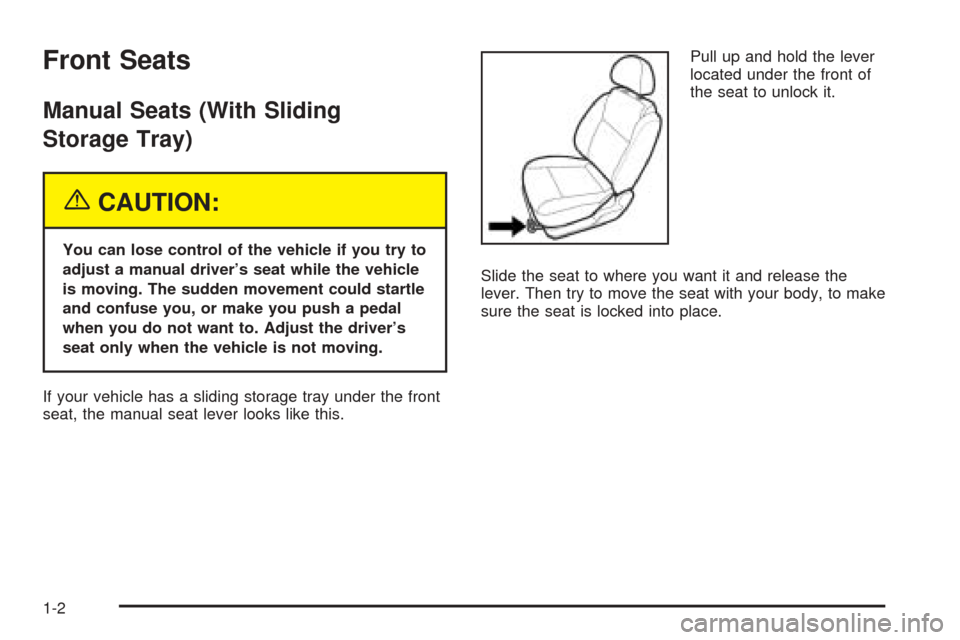
Front Seats
Manual Seats (With Sliding
Storage Tray)
{CAUTION:
You can lose control of the vehicle if you try to
adjust a manual driver’s seat while the vehicle
is moving. The sudden movement could startle
and confuse you, or make you push a pedal
when you do not want to. Adjust the driver’s
seat only when the vehicle is not moving.
If your vehicle has a sliding storage tray under the front
seat, the manual seat lever looks like this.Pull up and hold the lever
located under the front of
the seat to unlock it.
Slide the seat to where you want it and release the
lever. Then try to move the seat with your body, to make
sure the seat is locked into place.
1-2
Page 9 of 336
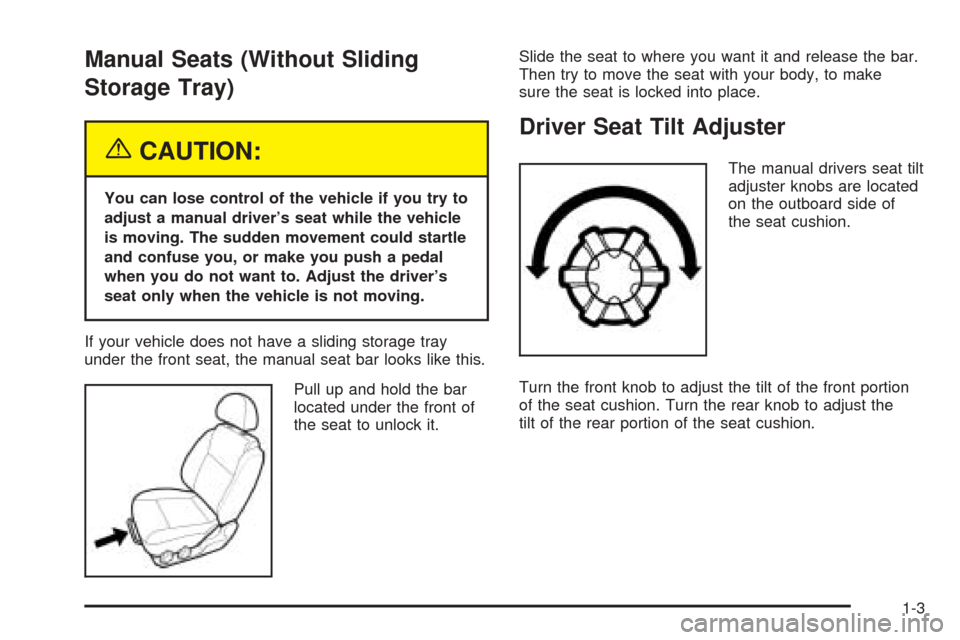
Manual Seats (Without Sliding
Storage Tray)
{CAUTION:
You can lose control of the vehicle if you try to
adjust a manual driver’s seat while the vehicle
is moving. The sudden movement could startle
and confuse you, or make you push a pedal
when you do not want to. Adjust the driver’s
seat only when the vehicle is not moving.
If your vehicle does not have a sliding storage tray
under the front seat, the manual seat bar looks like this.
Pull up and hold the bar
located under the front of
the seat to unlock it.Slide the seat to where you want it and release the bar.
Then try to move the seat with your body, to make
sure the seat is locked into place.
Driver Seat Tilt Adjuster
The manual drivers seat tilt
adjuster knobs are located
on the outboard side of
the seat cushion.
Turn the front knob to adjust the tilt of the front portion
of the seat cushion. Turn the rear knob to adjust the
tilt of the rear portion of the seat cushion.
1-3
Page 13 of 336
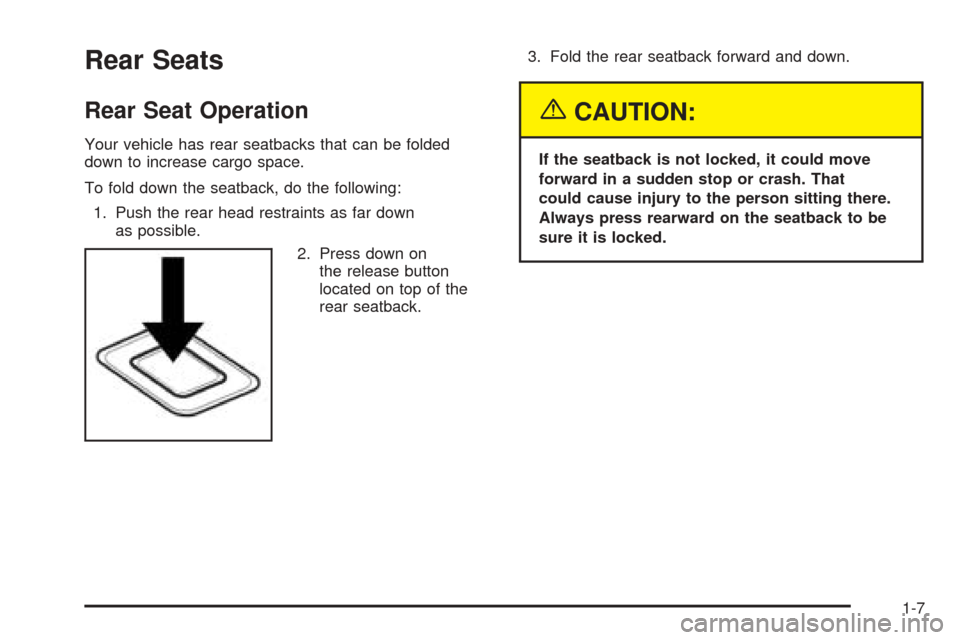
Rear Seats
Rear Seat Operation
Your vehicle has rear seatbacks that can be folded
down to increase cargo space.
To fold down the seatback, do the following:
1. Push the rear head restraints as far down
as possible.
2. Press down on
the release button
located on top of the
rear seatback.3. Fold the rear seatback forward and down.
{CAUTION:
If the seatback is not locked, it could move
forward in a sudden stop or crash. That
could cause injury to the person sitting there.
Always press rearward on the seatback to be
sure it is locked.
1-7
Page 15 of 336
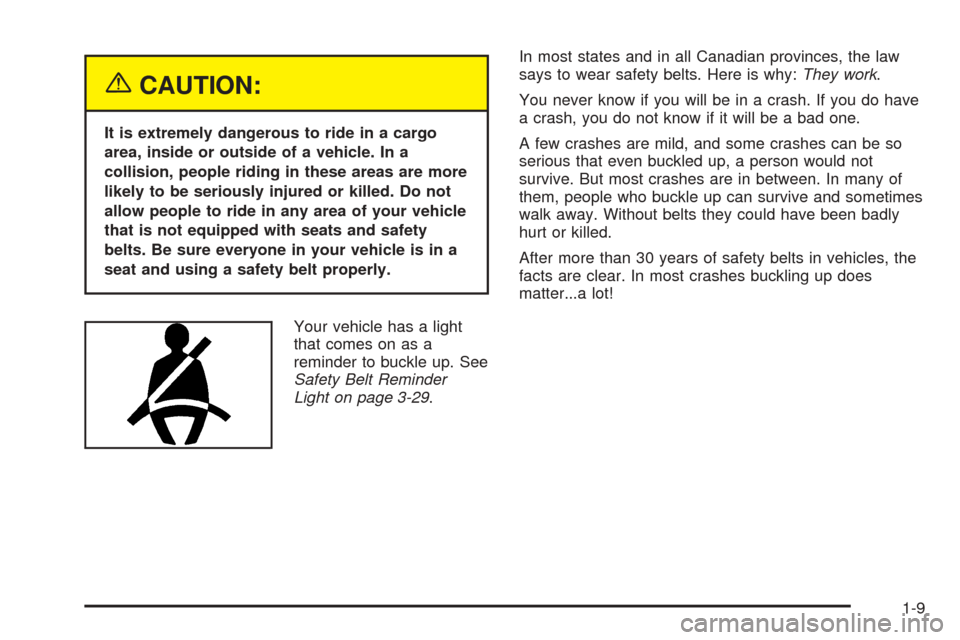
{CAUTION:
It is extremely dangerous to ride in a cargo
area, inside or outside of a vehicle. In a
collision, people riding in these areas are more
likely to be seriously injured or killed. Do not
allow people to ride in any area of your vehicle
that is not equipped with seats and safety
belts. Be sure everyone in your vehicle is in a
seat and using a safety belt properly.
Your vehicle has a light
that comes on as a
reminder to buckle up. See
Safety Belt Reminder
Light on page 3-29.In most states and in all Canadian provinces, the law
says to wear safety belts. Here is why:They work.
You never know if you will be in a crash. If you do have
a crash, you do not know if it will be a bad one.
A few crashes are mild, and some crashes can be so
serious that even buckled up, a person would not
survive. But most crashes are in between. In many of
them, people who buckle up can survive and sometimes
walk away. Without belts they could have been badly
hurt or killed.
After more than 30 years of safety belts in vehicles, the
facts are clear. In most crashes buckling up does
matter...a lot!
1-9
Page 20 of 336
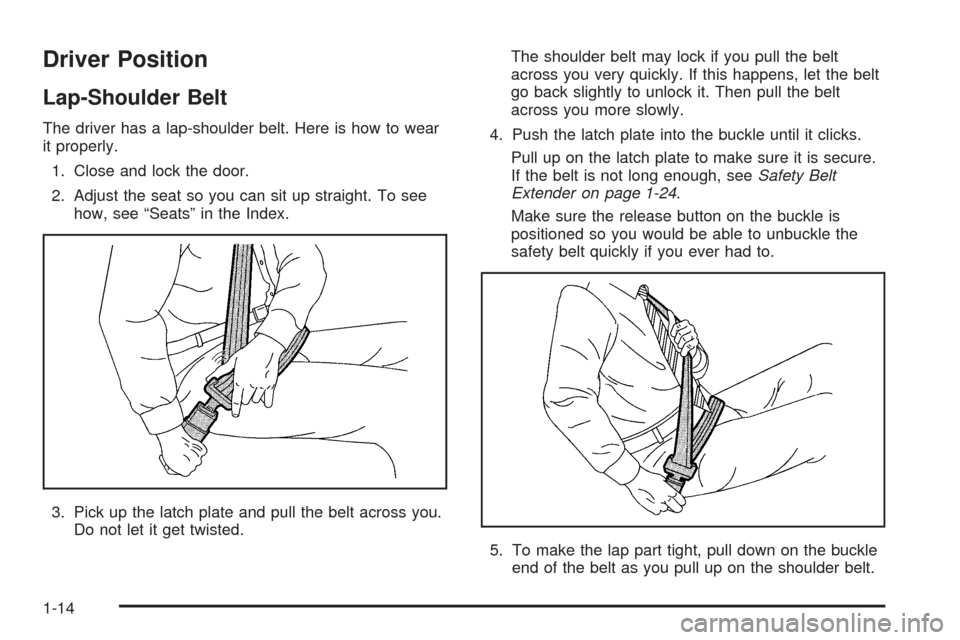
Driver Position
Lap-Shoulder Belt
The driver has a lap-shoulder belt. Here is how to wear
it properly.
1. Close and lock the door.
2. Adjust the seat so you can sit up straight. To see
how, see “Seats” in the Index.
3. Pick up the latch plate and pull the belt across you.
Do not let it get twisted.The shoulder belt may lock if you pull the belt
across you very quickly. If this happens, let the belt
go back slightly to unlock it. Then pull the belt
across you more slowly.
4. Push the latch plate into the buckle until it clicks.
Pull up on the latch plate to make sure it is secure.
If the belt is not long enough, seeSafety Belt
Extender on page 1-24.
Make sure the release button on the buckle is
positioned so you would be able to unbuckle the
safety belt quickly if you ever had to.
5. To make the lap part tight, pull down on the buckle
end of the belt as you pull up on the shoulder belt.
1-14
Page 30 of 336
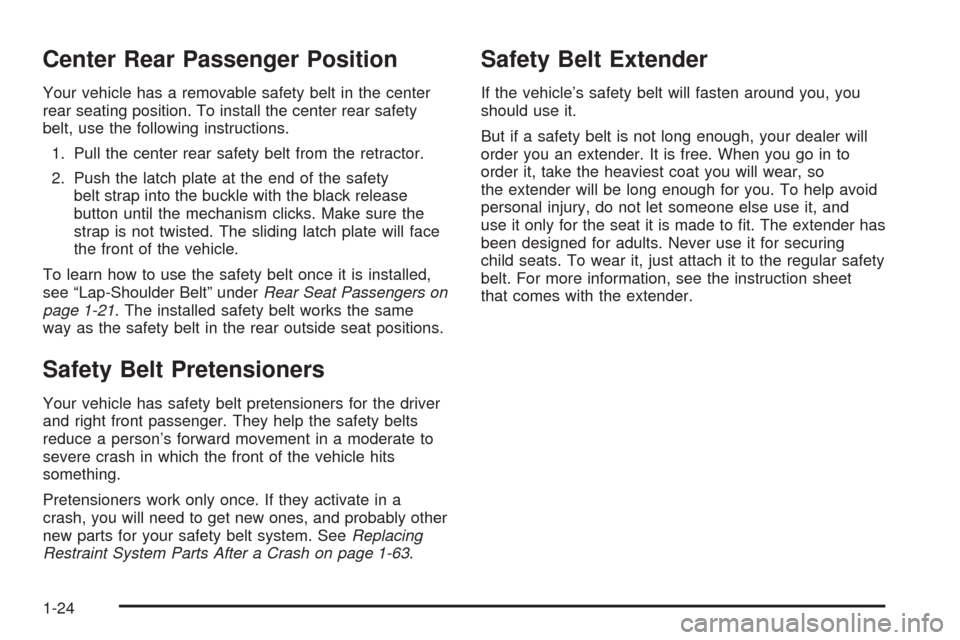
Center Rear Passenger Position
Your vehicle has a removable safety belt in the center
rear seating position. To install the center rear safety
belt, use the following instructions.
1. Pull the center rear safety belt from the retractor.
2. Push the latch plate at the end of the safety
belt strap into the buckle with the black release
button until the mechanism clicks. Make sure the
strap is not twisted. The sliding latch plate will face
the front of the vehicle.
To learn how to use the safety belt once it is installed,
see “Lap-Shoulder Belt” underRear Seat Passengers on
page 1-21. The installed safety belt works the same
way as the safety belt in the rear outside seat positions.
Safety Belt Pretensioners
Your vehicle has safety belt pretensioners for the driver
and right front passenger. They help the safety belts
reduce a person’s forward movement in a moderate to
severe crash in which the front of the vehicle hits
something.
Pretensioners work only once. If they activate in a
crash, you will need to get new ones, and probably other
new parts for your safety belt system. SeeReplacing
Restraint System Parts After a Crash on page 1-63.
Safety Belt Extender
If the vehicle’s safety belt will fasten around you, you
should use it.
But if a safety belt is not long enough, your dealer will
order you an extender. It is free. When you go in to
order it, take the heaviest coat you will wear, so
the extender will be long enough for you. To help avoid
personal injury, do not let someone else use it, and
use it only for the seat it is made to fit. The extender has
been designed for adults. Never use it for securing
child seats. To wear it, just attach it to the regular safety
belt. For more information, see the instruction sheet
that comes with the extender.
1-24
Page 31 of 336
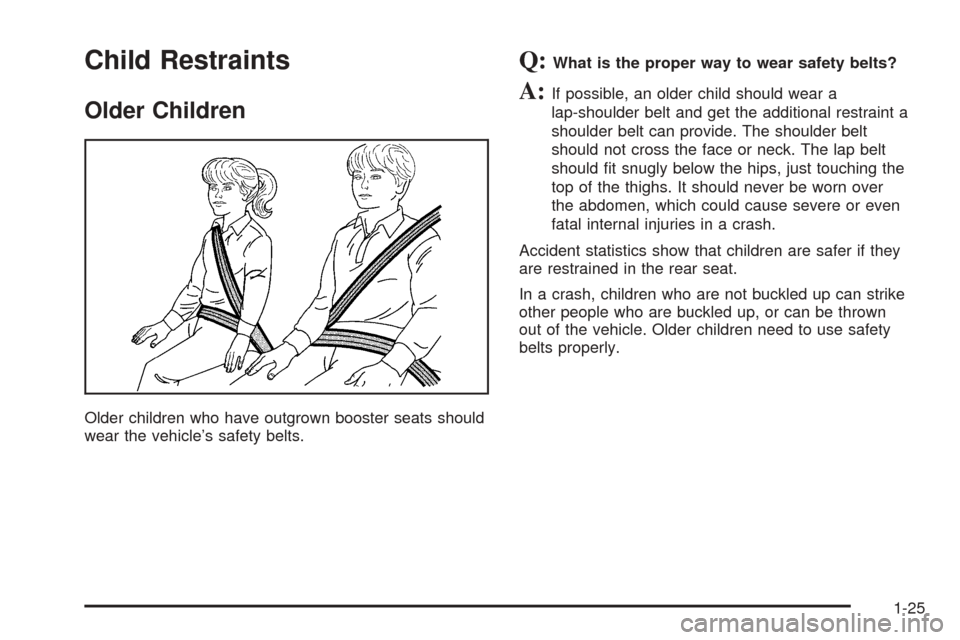
Child Restraints
Older Children
Older children who have outgrown booster seats should
wear the vehicle’s safety belts.
Q:What is the proper way to wear safety belts?
A:If possible, an older child should wear a
lap-shoulder belt and get the additional restraint a
shoulder belt can provide. The shoulder belt
should not cross the face or neck. The lap belt
should fit snugly below the hips, just touching the
top of the thighs. It should never be worn over
the abdomen, which could cause severe or even
fatal internal injuries in a crash.
Accident statistics show that children are safer if they
are restrained in the rear seat.
In a crash, children who are not buckled up can strike
other people who are buckled up, or can be thrown
out of the vehicle. Older children need to use safety
belts properly.
1-25